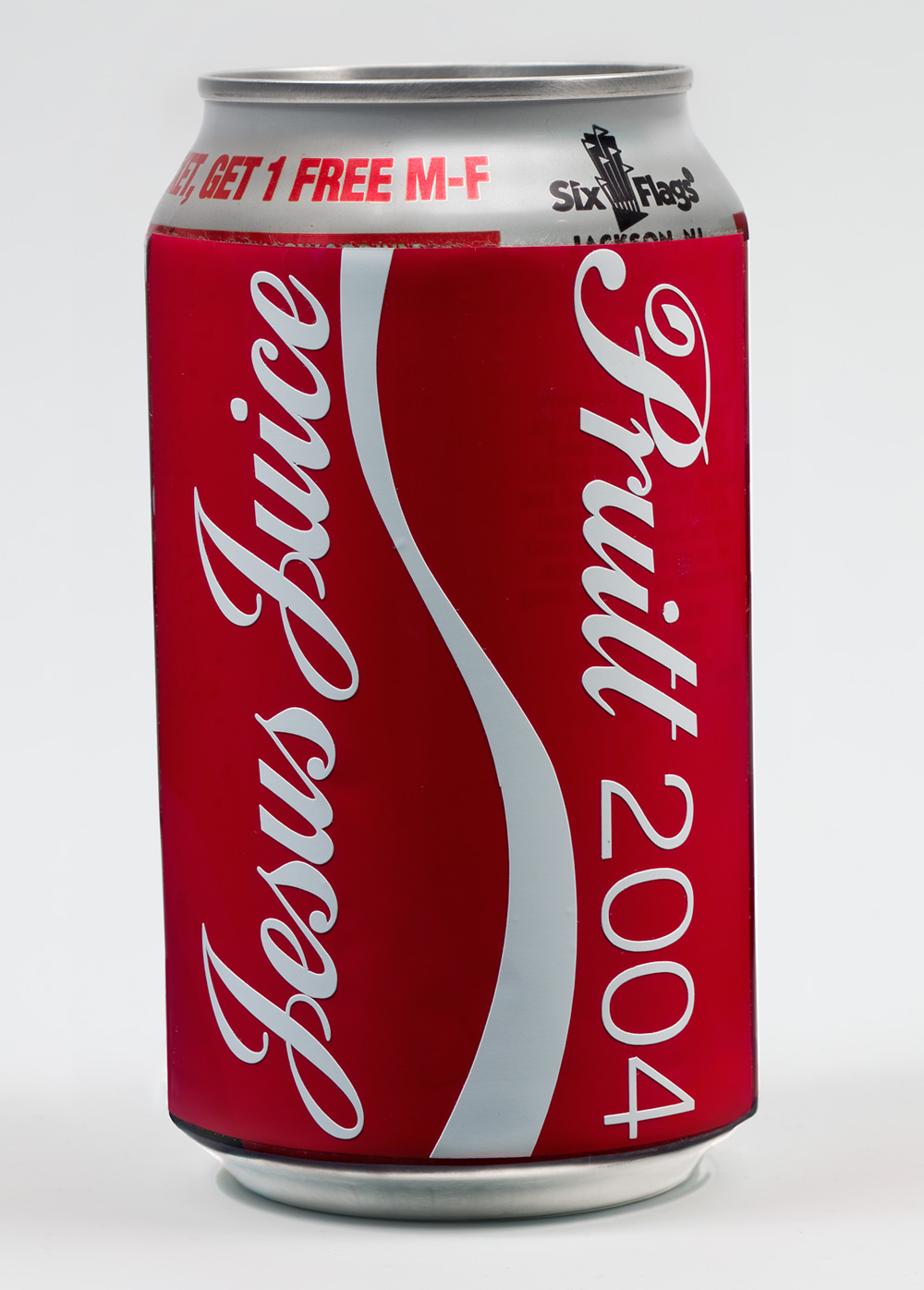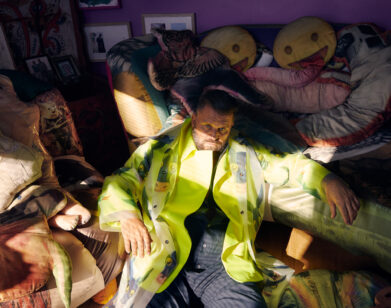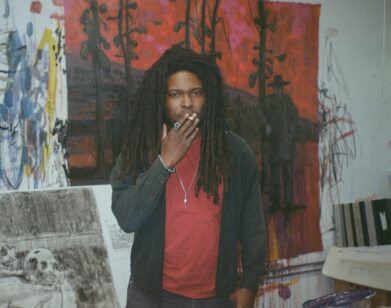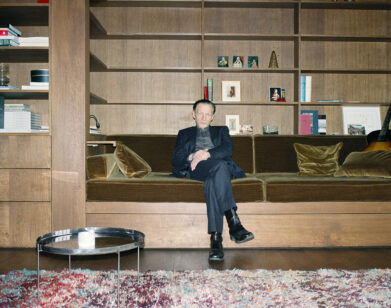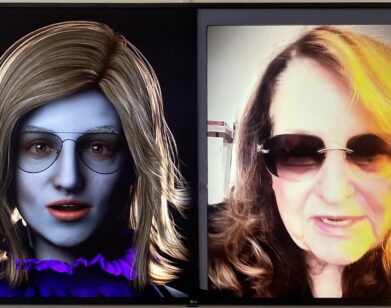Rob Pruitt
There’s great irony in the fact that Rob Pruitt is the man putting together the Guggenheim’s First Annual Art Awards, a sort of tongue-and-cheek version of the Oscars for contemporary American art. It’s the kind of irony more befitting a Hollywood film script than the New York art scene. On October 29, before an assemblage of heavyweights in the Guggenheim Museum rotunda, faux-champagne-bottle-in-ice-bucket lamp awards will be doled out to the winners of Solo Show of the Year, Group Show of the Year, Curator of the Year, and Artist of the Year, among a myriad of other categories. While a committee helped select the nominees, the awards show itself was 45-year-old Pruitt’s brainchild—his way of giving back to the art-world community that has made him one of its own unorthodox, uninhibited stars.
In the late 1980s, the Washington, D.C.–raised Pruitt was, along with Jack Early, part of the collaborative art team Pruitt-Early, a duo that was instantly touted as a pair of intrepid, iconoclastic newcomers—that is, until a 1992 show at Leo Castelli Gallery, where the two artists paid tribute to black culture by splashing paint on foil, shrink-wrapping posters of famous African Americans, and supplying their own rap soundtrack. Today that kind of show wouldn’t read as much of a shock, let alone a scandal, but in the early ’90s, the culture was still fully entrenched in the dicta of political correctness. Protests ensued, their work was accused of being racist, and, soon after, the pair disbanded.
Summarily pushed out of the art world, Pruitt took several years to find his legs again. In 1998, at a group show at an artist’s studio in New York’s Meatpacking District, he presented Cocaine Buffet a minimalist line of cocaine that stretched 16 feet across the space, as a sort of peace offering to the art world (which greedily accepted). Since then, Pruitt has thrived—or rather sensationally rebuilt his reputation—largely on that same ability to shock. His glitter panda paintings, first shown in 2000, might be his most recognized pieces to date. But in the last few years, he has also transformed a Victorian house in upstate New York into a Goth art installation, fashioned giant character-driven tombstones for everyone from Anna Nicole Smith to Charles Schulz, and created a sweeping, diaristic mural out of 3,000 iPhoto photos. Actor James Franco recently caught up with Pruitt, who was tending to preparations for the Art Awards, to discuss the festivities—as well as the gray area between celebration and critique that Pruitt himself has explored throughout his own career.

JAMES FRANCO: It’s funny that we are doing this on the phone because we both live in New York City.
ROB PRUITT: I’m in Montauk. Where are you?
FRANCO: I’m in Asheville, North Carolina, near where Black Mountain College used to be. I’m here for a poetry program. F. Scott Fitzgerald used to come and stay at the hotel I’m in because his wife, Zelda, was in a nearby institution. So, tell me about the Art Awards at the Guggenheim.
PRUITT: The Guggenheim came to me and wanted to know if I had any ideas for reimagining their annual fundraiser because I guess it’s just basically been a gala ball for many years. I thought it would be a nice idea to have an art-world Oscars with different categories . . . It would basically follow the format of the Oscars as closely as we could and make it this super-entertaining parody. But I wanted it to have its own integrity as well, where we could do it year after year and the recipients would be proud for having won and would display their trophies on their mantels.
FRANCO: I guess England has the Turner Prize, so it’s not that crazy.
PRUITT: Yeah, it’s not completely off the wall.
FRANCO: So how did you pick the nominees?
PRUITT: We established a committee to come up with the nominees for the different categories. I don’t know at this point who’s going to win what. I’m just now in the midst of producing the show, finding hosts and presenters, and building a set.
FRANCO: Will there be live entertainment and performance art pieces or something?
PRUITT: Yeah, there will. Maybe we’ll ask Pharrell to perform. I’m not really sure. Do you think you would consider presenting an award?
FRANCO: I’d love to do that. But I do think it’s interesting that now you’re celebrating the art world after you’ve spent all of this time in your career fighting it. You’re in Montauk right now, but I know you used to have a house in upstate New York. I never saw it in person but it was something of an art piece itself, as I understand.
PRUITT: Yeah. We bought a dilapidated old Victorian house that sat high on a hill in this village in upstate New York called Fleischmanns. The town was sort of set up by Charles Fleischmann, the founder of the Fleischmann Company famous for its yeast, and his family had a couple big mansions and paid for the public parks. The town fell into disrepair over the past 80 years, and Jonathan Horowitz and I thought it would be really cool to buy this very prominent house and set it up as like a public art piece that could possibly help revitalize the village.
FRANCO: I’ve seen pictures of the inside of the house, with all of the lamps and chandeliers, many of which were bought at Goodwill and made part of the artwork. I was thinking about that in relation to your work with the panda glitter paintings . . .
PRUITT: Well, there is a connection. There is something that runs through all of my art-making practices—at least the paintings and sculptures—which is that they are basically blow-up versions of dining-room-table craft projects. Like, I’ve made hundreds of paintings out of glitter. I’ve really enjoyed letting the world know that not everything is so mystified or so regulated to expertise—that you can make something really beautiful with a little ingenuity and some supplies from Michaels [craft shop].
FRANCO: It’s like your 1999 piece 101 Art Ideas You Can Do Yourself. One aspect of it is a Martha Stewart–type approach, right? That anybody can do it, that art isn’t so mysterious and inaccessible.
PRUITT: Yeah, that’s exactly it. When I sat down to make the 101 Art Ideas project, I was really thinking about how my parents didn’t have the advantages that I had of going off to college and studying something that is really very impractical or nonessential in many respects: an art-school education. So I was thinking, my parents provided me with this gift of being able to do exactly what I want to do, which is being an artist, so 101 Art Ideas was my gift to them. It was my attempt to explain to them what it is that I do. Your average person probably will never go into a New York gallery and see what’s being made today. It’s still a closed-off world. So I wanted to make the statement that art is really a lot more accessible than most people would imagine—that it’s not completely inscrutable and esoteric and just for the rich and educated. In the end, art is really just about developing a sensitivity to your environment and making comments about the world you’re living in in a beautiful way.
FRANCO: But I think there’s also another side to that project. It seems to me that while you’re asking everyone to engage in the world, you’re also giving them a way of critiquing it. It’s almost 101 formulas for breaking out—like, you suggest sitting on the toilet backward or spending an entire day in a costume. That’s obviously a way of breaking out of the monotonous way of proceeding.
PRUITT: Yeah. It’s a way of shaking up your complacency. It’s a given that everyone uses the toilet at least once per day, but probably not too many people sit on it backward. So a mundane activity can suddenly be read in a whole new way with one simple gesture.
FRANCO: I don’t know if you want to talk about your infamous show at Leo Castelli Gallery in 1992, but this toying with the boundaries of the art world—and coming in and out of it—is a constant theme of your career, isn’t it?
PRUITT: I think that the point that you make is a pretty exciting one within the world of Rob Pruitt. I think 101 showed that I am rather nonessential—like, you don’t need to look at my work, you can do it yourself. I’m not really interested as an artist in making a masterpiece. I pretty much show all of my output. I don’t throw anything away. You mentioned the Castelli show, and if one were to find flaws with that show or see it as a mistake, then that’s fine by me. I like this idea of learning and growing up publicly and not cleaning up the process so that everything that enters the gallery space is flawless and perfectly done. I mean I’m making my first monograph right now, which comes out in April.
FRANCO: It’s called Pop Touched Me?
PRUITT: Yeah. And when I sat down with my editors and looked at everything I’ve signed my name to over the last 17 years, I thought a lot of it wasn’t that good. But I wouldn’t take any of it back. I’m not embarrassed. I feel like I’m learning along the way, and that trying is better than not trying at all. Some of the art I’ve made, I’m really proud of. But some of those things are total clunkers.
FRANCO: You once said that your 1998 piece Cocaine Buffet was, on one level, a publicity stunt, but it also had art history built into it: minimalism infused with contemporary culture visibility.
PRUITT: The cocaine thing was in a sense a publicity stunt, but it was also a thinly veiled self-portrait or a confession. I mean, it was very autobiographical. Not that I loved drugs, but I was no longer collaborating with Jack Early. I was trying to carve out my own identity. And that involved a couple of problematic situations for me. If you rose to some popularity or notoriety as part of a collaborative team, how do you reemerge with a solo identity? How do I maintain things about Pruitt-Early that I still feel close to, but create a new voice that’s exclusively my own? The Pruitt-Early collaboration ended because the show at Castelli was so badly received. Most of the critical responses to it were that it was racist, an abomination. How could a project like this pass the inherent screening that the art world has of only showing the best, most vital things? How could such a racist project actually end up in these hallowed halls of the Castelli Gallery?
FRANCO: [laughs] How did it go up?
PRUITT: Well, Leo came to us because we had established a certain amount of success and renown in a very short period of time.
FRANCO: With those sculptures for teenage boys?
PRUITT: Yeah, Artwork for Teenage Boys. Those images weren’t generated by us—we just sort of collected and organized them. I think Leo Castelli had an affinity for the way they looked because it was reminiscent of work he had pioneered in the 1960s, so he offered us a show without knowing what the project would be. As it was being developed, he did make studio visits. I think he thought that it was going to be very exciting. We were simply trying to make a project that celebrated the very rich black creative culture that emerged after so much slavery, racism, and oppression. That’s truly what we were trying to do. The fashion of the day was to make identity-issue work, you know—if you were part of a particular group then you would make work about your participation in that group.
FRANCO: Yeah.
PRUITT: So as two white, gay men, it was strange to people that we were making this body of work, celebrating achievements of black American culture. I think the exhibition did fuel the fires of the racist reading, because we shifted tone. I mean, Artwork for Teenage Boys did involve pretty offensive, sexist, misogynistic expressions of white, male teenage culture that we’d basically gotten from T-shirt iron-ons and rock music lyrics. That was our first project right out of art school—not that I’m making excuses for it. I thought it was pretty good. We were trying to make a portrait of this segment of the population who was the enemy, who harassed us in high school, who beat us up behind the gym. It was an interesting exercise in politics and aesthetics just to gather all of this really vile information and see what it looked like together. I really viewed that project as a portrait of the enemy. And then we did shift gears. But the Black show was not a portrait of the enemy. It was a celebration of a group of people that we felt aligned with. Growing up gay in the ’70s and early ’80s, I think that we just felt as if we had some of the same liberties and rights breached as well. It’s difficult to explain away all of the reactions that happened 20 years ago. Obviously, I want the story to go in my favor and to not be the villain anymore. But I also want to be responsible for what I did at every point in my life.
FRANCO: Where did you go to art school?
PRUITT: Well, first I went to the Corcoran College of Art and Design, which is a museum school in Washington, D.C. But then I switched to Parsons The New School for Design in New York. I loved school. My dream was to move to New York, and at Corcoran I met this really great person, Tim Gunn, who is now on Project Runway. He’s the person who admitted me to art school at the Corcoran and then the following year, he left to go to Parsons. It wasn’t exactly that I followed him, but my father won the Maryland State Lottery and got, like, two million dollars. We had been a pretty poor family, but that all changed.
FRANCO: Wait—your dad won the lottery?
PRUITT: Yeah. Back in the early ’80s.
FRANCO: I can’t believe that actually happened. And who would’ve thought that Project Runway had such a basis in the contemporary art world?
PRUITT: [laughs] I know. Tim Gunn is truly amazing. I owe a lot to him. He really saw something in me when I was just 17. He was the first person who ever bought something that I made. It was a four-panel drawing about incest. It was a family of four in all different sexual combinations. Like mother and father, mother and son, mother and daughter . . . It was basically an exercise in shock value, and it was also based on Sol LeWitt and reducing art to a mathematical equation. Maybe I haven’t actually moved too far away from that piece, because I still always include a certain amount of shock and base work on a system.
James Franco is an actor and writer. He lives in New York City.

